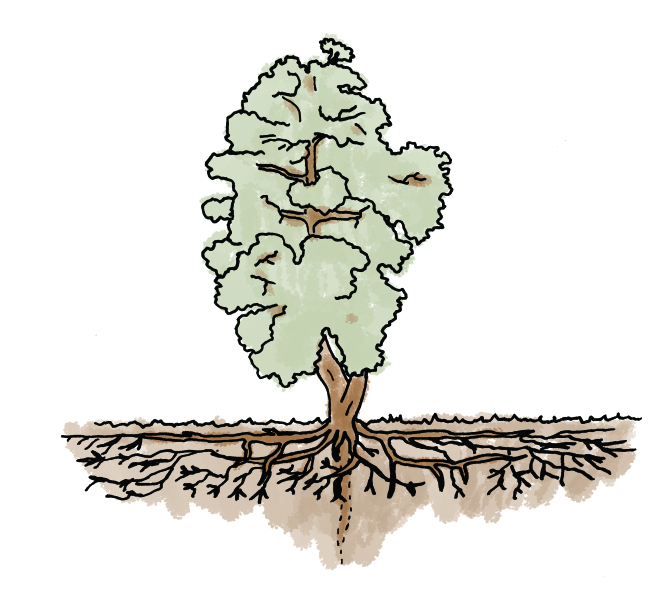Anatomy of a Root System
In order for your tree to gain nourishment from the Earth, a complex root system exists beneath the ground. To understand how to best care for your tree, awareness of all parts and functions of this root system is essential. 
The purpose of tree roots is to:
- Uptake water, oxygen, and minerals
- Transport water and minerals toward the inner trunk
- Support the tree structurally
- Promote growth
Absorption
Large trees have over 30 miles of roots, with 5-million root tips, including many small colonies of beneficial fungus. The work of the root system is fueled by sugar from the leaves, using oxygen found between soil particles. One-celled projections, or root hairs, do the work of absorbing water and minerals from the soil. Beneficial fungae, called mycorrhizae, live on feeder roots and also contribute to the collection process.
Once the water and minerals have been collected, they transfer into the thin conducting roots, which run alongside the absorbing roots and carry water and minerals back toward the trunk of the tree.
Outgrowth
The length and depth of root growth depends on the amount of space given the plant. Conducting roots may extend outward as far as 2 or more times the height of the tree without barriers and disturbances.
Conducting roots then converge into brace roots, which are thick and grow laterally, providing much of the necessary support for the tree. Roots continue to extend as-needed, growing in an ever-widening disk around the tree.
Root Limitations
While roots actively search for oxygen, there is very little available below 18” in clay soil. In sandy soil there may be more oxygen at deeper levels, but water and minerals at those depths will be limited. A high water table will further limit oxygen penetration, and bedrock may prevent roots from digging deeper to continue their search.
What You Can Do
Because it is difficult to treat unhealthy roots, your tree care best practices for a vigorous root system include:
- Adequate growing space: Make sure that your roots have room to grow. This includes well-conditioned soil of between 16 to 24 inches deep, with sufficient water and oxygen. To keep your tree well-hydrated, give the entire root system a long, deep watering. Leave time in between waterings for the soil to dry out.
- Avoid injuries to the roots: Injuries may include soil compaction, soil depth changes, mechanical injury, and improper watering and fertilization techniques. Minimizing soil compaction includes removing compacted soil and replacing it with non-compacted soil, making space for adequate drainage before planting. Fertilization damage can be avoided by applying nitrogen fertilizer to established trees after spring leaf expansion.
Understanding the best way to care for your tree means caring for your tree’s root system. By following the tips above, you will be able to adequately meet the needs of your tree’s nutrient-seeking roots and provide care that ensures a long and healthy life for your tree and garden ecosystem.



